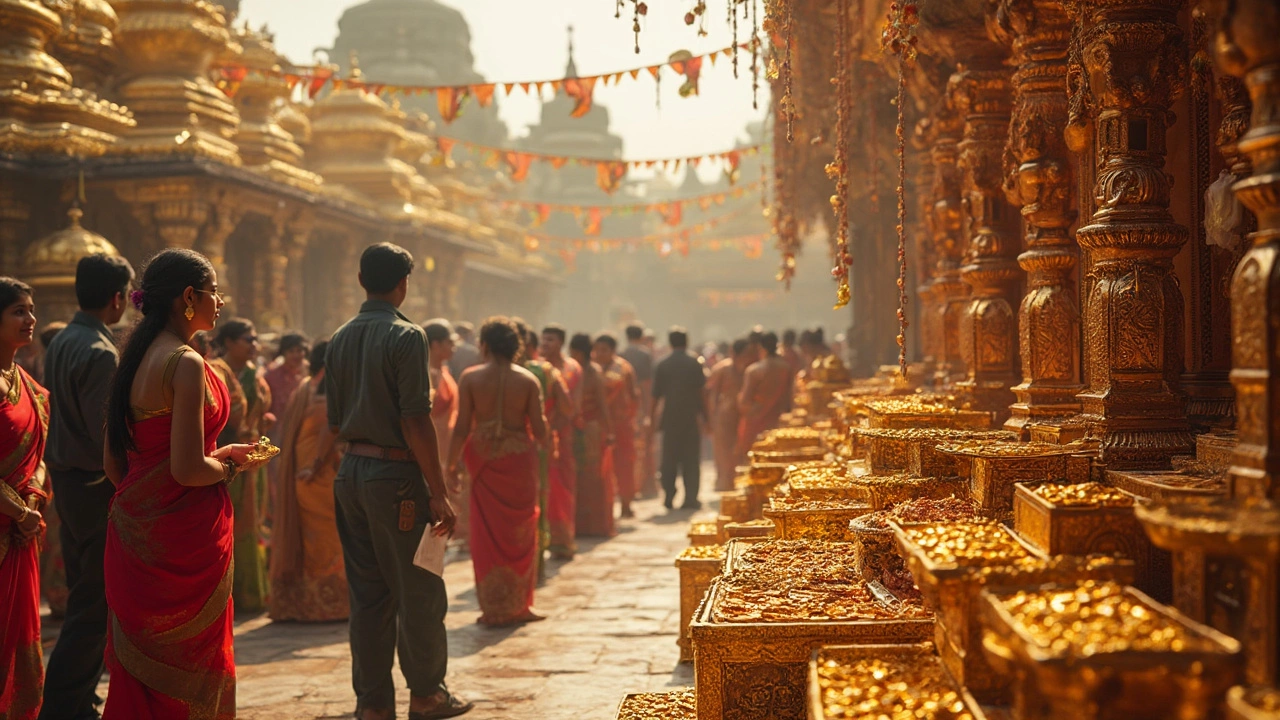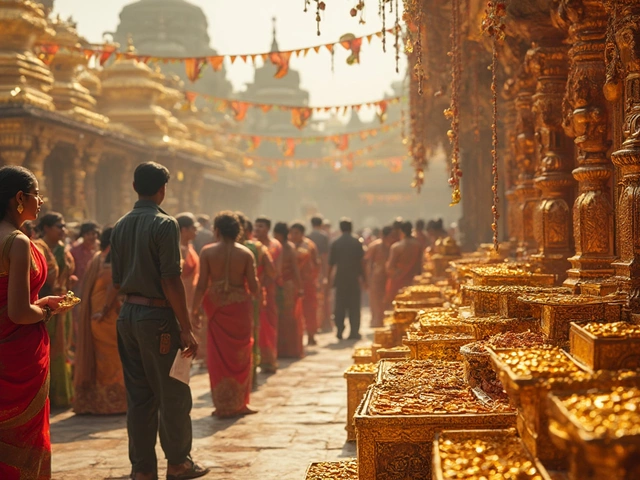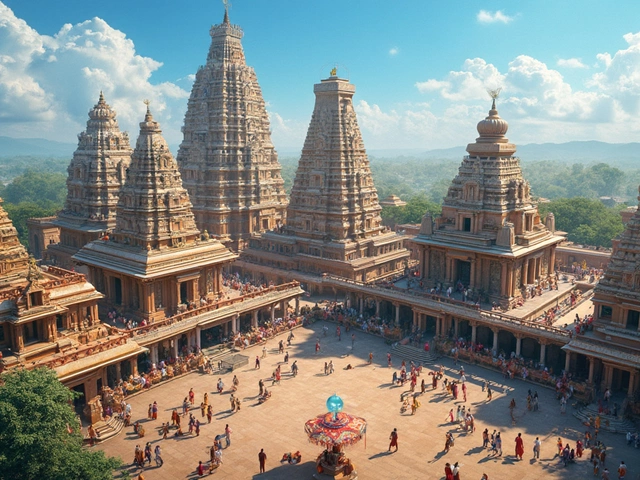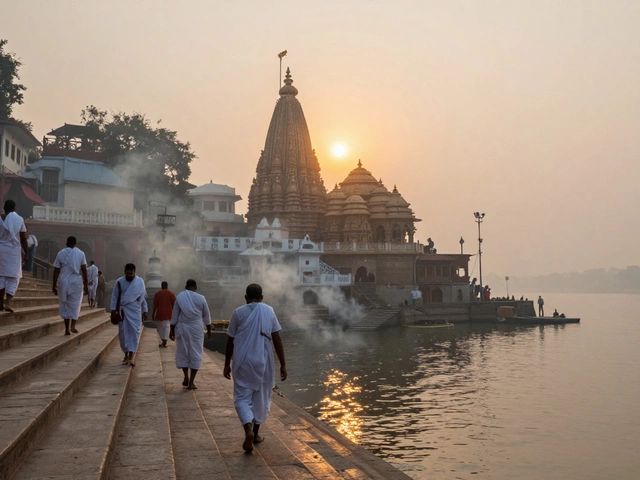India's temples aren't just spiritual centers—they're some of the richest institutions in the world. We’re talking cash, gold, jewels, and land that could make even Fortune 500 companies jealous. Ever wondered which religion holds the most wealth in India? It’s not even close: the numbers are staggering.
The jaw-dropping wealth locked up in Indian temples isn’t just legend. People donate everything from coins and cash right up to gold bars, and these treasures are stored in temple vaults that get audited with police and bank officials standing by (yes, really). Some temple trusts manage more money than the annual budget of small countries. Curious about which faith's temples rake in the most? Let’s face it—if you’re thinking about a temple tour, the story behind their wealth adds a pretty wild twist to your itinerary.
- Breaking Down Temple Wealth in India
- Hinduism: India’s Wealth Powerhouse
- How Do Temples Get So Rich?
- Other Religions and Their Wealth
- Famous Rich Temples You Can Visit
- Tips for Touring Wealthy Temples
Breaking Down Temple Wealth in India
In India, the phrase “rich as a temple” isn’t an exaggeration. The wealth that’s concentrated in some of the country’s temples is off the charts. Start with the obvious: Hindu temples lead the pack. The Tirupati Balaji Temple in Andhra Pradesh, for example, sees annual donations (in cash and gold) that regularly top $100 million. That’s more than the budget of some small Indian states.
Mumbai’s Siddhivinayak Temple is another big player—it reportedly collects over ₹125 crore (about $15 million) every year, not even counting gold and jewels. Then there’s Kerala’s Sree Padmanabhaswamy Temple, which stunned the world a few years back when they opened a few old underground vaults and found gold coins, statues, and precious stones. Just one vault’s contents were valued at over $20 billion. Now, there are rumors that some vaults have never been opened at all.
It isn’t just about donations in the offering boxes. Many temples own massive pieces of land, real estate, and even stocks. Some of these religious trusts own entire residential neighborhoods, farmland, and even shopping complexes that pull in steady rents. Managing these assets isn’t like running a family heirloom; it’s more like handling a big business.
| Temple | Estimated Assets (USD) |
|---|---|
| Tirupati Balaji | $30+ billion |
| Padmanabhaswamy Temple | $20+ billion |
| Siddhivinayak Temple | $150 million+ |
| Shirdi Sai Baba | $100 million+ |
If you’re curious about why so much wealth lands up in temples, the answer’s pretty simple. Donations are seen as a way to gain spiritual merit, and big festivals or personal milestones like weddings can spark massive gifts. And since there’s no one standard way of tracking or managing temple donations, the numbers can keep stacking up—sometimes for centuries.
Hinduism: India’s Wealth Powerhouse
When folks talk about the richest religion in India, it’s Hinduism that takes a huge lead. The numbers coming out of major Hindu temples are on another level. For a quick reality check, the Padmanabhaswamy Temple in Kerala alone is reported to have treasures valued at over $22 billion (yep, billion with a 'b')—and that’s just from what’s been opened and counted so far. There are vaults that officials haven’t even touched yet.
The Tirupati Balaji Temple in Andhra Pradesh isn’t far behind. It’s easily one of the most visited temples on Earth, pulling in crores—sometimes close to ₹3,000 crore (over $350 million) every year from donations, offerings, and rituals. During special festivals, the foot traffic and donation chest can both spike through the roof. If you want to see cash flow in real time, just visit during Brahmotsavam—you’ll see everything from hair to gold coins being offered.
Compare these numbers with other religious institutions in India, and it’s not even a contest. Hindu temples not only hold unmatched assets, but they also own vast tracts of land, tons of real estate, and even agricultural fields. For years, big names like Siddhivinayak in Mumbai, Shirdi Sai Baba in Maharashtra, and Vaishno Devi in Jammu have managed donations worth hundreds of crores every year.
| Temple | Estimated Wealth | Highlight |
|---|---|---|
| Padmanabhaswamy (Kerala) | $22+ billion | Unearthed vault treasures, diamonds, gold coins |
| Tirupati Balaji (Andhra Pradesh) | $6-8 billion | Cash & gold donations, massive daily visitors |
| Siddhivinayak (Mumbai) | $200+ million annually | Pilgrim donations, gold offerings |
| Shirdi Sai Baba (Maharashtra) | $100+ million annually | Daily offerings, huge pilgrim base |
Why is Hinduism so wealthy in India? It’s a mix of tradition and sheer numbers. Hinduism is the country’s largest religion by population, so the temples draw in more donations just by scale. It’s also common for families to donate after fulfilling personal wishes or milestones. Gifts can include cash, jewelry, and even land deeds.
Many temples run trusts that use this money for everything from community kitchens to funding hospitals, schools, and old-age homes. While the spotlight shines on their vaults, a big chunk of wealth actually gets put back into the community—or at least, that’s how it’s supposed to work when things run smoothly.
How Do Temples Get So Rich?
If you’ve ever tossed a coin in a temple donation box, you’re one of millions helping Indian temples stack up serious wealth. The richest religion in India, Hinduism, is front and center here, with its temples pulling in massive donations from regular people, rich businessmen, movie stars, and even politicians. For a lot of devotees, giving isn’t just tradition—it’s about faith and good karma.
Money flows in every day, with donations ranging from a few rupees to gold jewelry and luxury cars. Temples like Tirupati in Andhra Pradesh and Padmanabhaswamy in Kerala accept all kinds of offerings, and they even auction off some of these gifts to raise funds for maintenance and charity work. During peak festivals like Diwali or temple anniversaries, the donation rooms look like vaults in a bank.
Besides direct donations, some temples own huge chunks of land— we’re talking thousands of acres. These lands generate income through farming, renting to businesses, and even running schools and hospitals. Temples also make money through investments. The Tirumala Tirupati Devasthanam Trust, for example, invests part of its donations in government bonds and fixed deposits. That’s not all: entry fees, sales of prasad (the blessed food), and temple shops add to the kitty.
| Temple | Annual Donations (Approx.) | Land Holdings |
|---|---|---|
| Tirupati Balaji | ₹3,000 crore | Over 12,000 acres |
| Padmanabhaswamy | Not publicly disclosed | Hundreds of acres, plus gold hoards |
| Sai Baba, Shirdi | ₹400 crore | Large real estate in Shirdi |
An often-overlooked point: in many cases, these temples don’t pay tax on their income, since they’re considered charitable or religious trusts. That means more funds go right back into temple activities or get reinvested, making Indian temples some of the richest religious institutions on the planet. If you’re planning a temple tour, watch for the lines at donation counters and the buzz around treasure vaults—you’ll see India’s spiritual and financial heartbeat up close.
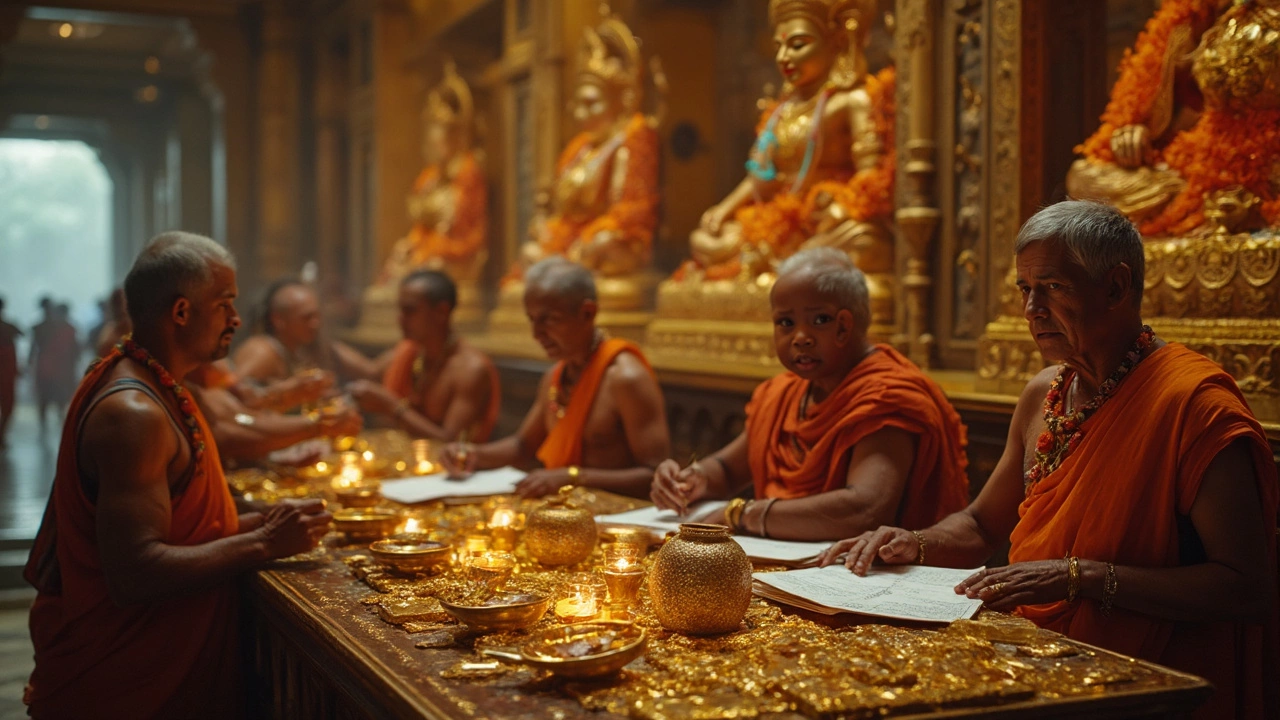
Other Religions and Their Wealth
When most people think of religious wealth in India, their mind jumps to massive Hindu temples. But India is home to many faiths that also have impressive assets and some hidden gems of their own, so let’s break it down.
Sikhism, for example, operates gurdwaras that pull in sizeable donations, especially the famous Golden Temple in Amritsar. While Sikh gurdwaras don’t stash mountains of gold, they do handle massive daily donations and run massive free kitchens (langars) that feed tens of thousands every day. One fun fact: the Golden Temple’s kitchen uses over 100,000 rotis on busy days, all powered by donations.
Muslim shrines like the Ajmer Sharif Dargah in Rajasthan attract millions of visitors a year. The donations are significant but aren’t always publicly audited. Some big Sufi shrines manage enough to fund schools, hospitals, and social programs. While their total assets are way below Hindu temple heavyweights, their social impact is hard to ignore.
Christian churches, especially Catholic ones, manage wealth well beyond what most people expect. States like Kerala, Goa, and Tamil Nadu have historic churches with land, properties, and steady donations. These churches don’t match the sheer gold and rupee reserves of the largest Hindu temples, but their real estate is nothing to sneeze at.
| Religion | Top Institution | Estimated Annual Donations (INR) |
|---|---|---|
| Hinduism | Tirupati Balaji Temple | 650+ crore |
| Sikhism | Golden Temple | 300+ crore |
| Islam | Ajmer Sharif Dargah | 100+ crore |
| Christianity | Velankanni Church | 80+ crore |
Jain and Buddhist organizations focus more on philanthropy, funding schools and hospitals over hoarding treasure. Jain temples like the Palitana cluster are beloved for their white marble splendor, not vaults stacked with gold.
Here’s the bottom line: Hinduism leads the pack in temple wealth, but other faiths in India do pretty well, especially when you factor in the scale of their charitable work and property. If you’re temple or shrine-hopping, you’ll find rich stories and surprising resources across every major religion.
Famous Rich Temples You Can Visit
If you want to actually see where the temple wealth flows, you don’t have to look far. Some of India’s most visited temples are also the richest—bursting with cash, gold, donated jewelry, or even sprawling acres of land. These aren’t just spiritual hotspots; they’re treasure vaults on public display.
- Tirupati Balaji (Tirumala Venkateswara Temple), Andhra Pradesh: Not just the richest temple in India, but often listed among the world’s wealthiest religious places. With an annual income crossing ₹2,500 crores, regular gold and jewelry offerings, and daily crowds in the tens of thousands, this temple is a financial powerhouse. The temple has over 10 tons of gold reserves held in banks—now that’s heavy devotion.
- Padmanabhaswamy Temple, Kerala: Probably the most talked-about after those famous treasure vault discoveries in 2011. Vault B alone is rumored to hold priceless antiques and gold, adding up to at least $20 billion in estimated assets. Tourists gawk at the fortress-like temple and its air of mysterious affluence. As the Times of India quoted:
"With its massive temple vaults and mythical legends, Padmanabhaswamy is India’s ultimate treasure chest."
- Shirdi Sai Baba Temple, Maharashtra: It isn’t ancient, but Shirdi sees nearly as many donations as the big old sites—roughly ₹300-₹400 crores per year. The trust runs hospitals and schools across India, all fueled by visitor generosity.
- Siddhivinayak Temple, Mumbai: City dwellers know this is the place celebrities, politicians, and local folks alike go for blessings. The temple receives about ₹125 crores each year, enough to fund social projects and keep the place spotless, despite constant traffic.
- Vaishno Devi, Jammu & Kashmir: Tucked in the mountains and drawing millions of pilgrims annually. The shrine board runs massive operations funded by offerings, with annual temple proceeds easily crossing ₹500 crores.
Curious how these temples stack up against each other? Here’s a quick snapshot:
| Temple | Estimated Annual Donations (₹ Crores) | Unique Feature |
|---|---|---|
| Tirupati Balaji | 2,500+ | Gold reserves, Non-stop crowds |
| Padmanabhaswamy | Unknown* | Historic vaults, Secret treasures |
| Shirdi Sai Baba | 300-400 | Modern philanthropy, mass tourism |
| Siddhivinayak | 125+ | Mumbai’s celeb hotspot |
| Vaishno Devi | 500+ | Hill shrine, record pilgrim numbers |
*Padmanabhaswamy’s true cash flow is hard to estimate with so much old treasure still not fully cataloged.
If you’re thinking of a temple tour in India, these places are worth it, not just for the spiritual vibe, but to witness how faith and finance blend on a mind-blowing scale. Remember, most of these temples have strict dress codes and time slots—book in advance, and always check the local rules before walking in with cameras or gadgets. If you’re into numbers or history, guided tours can spill out juicy treasure facts the regular visitor misses.
Tips for Touring Wealthy Temples
If you’re planning to check out some of the richest religion in India hotspots—like Tirupati or Padmanabhaswamy—there are a few things you need to know before you go. These temples don’t just draw crowds for their spiritual vibes, but the treasures, traditions, and strict rules are on a totally different level.
First, expect long lines. Tirupati Balaji Temple gets more than 50,000 visitors a day, and during festivals, it can go way above 100,000. It pays to book your entry darshan (temple viewing) online. Most rich temples have apps or official sites—use them to dodge the queues.
Here’s a checklist to keep your temple tour smooth:
- Dress code is a big deal. At Padmanabhaswamy Temple in Kerala, men have to wear a mundu (a white wrap) and no shirt is allowed. Women need a saree or a full-length skirt and blouse. They’ll rent you the right outfit at the entrance if you forget.
- No cameras allowed inside. You’ll see jaw-dropping idols and gold, but almost every wealthy temple bans phones and cameras past the main gate. If you want pictures, snap them outside before you go in.
- Donations are how these temples thrive. They’re not just about coins. People donate jewelry, land, and even lottery winnings (yes, there are real cases of that at Siddhivinayak Temple in Mumbai). If you want to leave a mark, every temple offers donation receipts, and the bigger ones even have digital payment options now.
- Watch the timings. Rich temples are famous for rituals and spiffy timings. At Shirdi Sai Baba temple, for example, the main aarti can start as early as 4 AM. Check the schedule on the official website and get there early to grab a good spot.
If you’re eyeing the must-see temples, here’s some quick data on donation volume. Just for perspective:
| Temple | Estimated Annual Donations (INR) | Visitor Count (Daily Avg.) |
|---|---|---|
| Tirupati Balaji | ~₹1,200 crores | 60,000+ |
| Padmanabhaswamy | ~₹200 crores | 3,000+ |
| Siddhivinayak | ~₹150 crores | 25,000+ |
The vibe at these temples is unique because the management is tight and everything—from security checks to crowd movement—is run like clockwork. Security is serious, especially at the entrances. Metal detectors and bag checks are standard after headline-making gold discoveries.
"The true wealth of these temples might be in gold and cash, but their real value is in the faith and stories of the people who visit," says Ramesh Menon, a well-known Indian heritage writer.
If you want a close look at treasures (like at the Golden Temple or Tirupati), look for special tour slots with guided explanations. Some temples offer these for a fee—they’re worth it if you love history and behind-the-scenes details.
One last thing: each Indian temple has its own quirks. Ask locals about hidden traditions or rituals. Sometimes, you’ll get to see ceremonies that aren’t listed anywhere, just by chatting with the right person at the right time. It’s not just about seeing gold—it's about soaking up the stories that make these temples more than just wealthy buildings.
